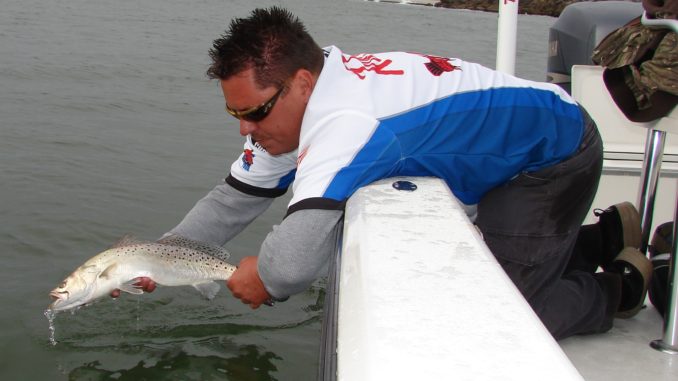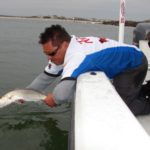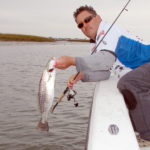
Follow the falling water to great September speckled trout in the waters around Masonboro Inlet and Wrightsville Beach, N.C.
As he slowly motored away from the dock, guide Jot Owens laid out his game plan. Speckled trout are affected greatly by the tide, he said, and he wanted to work with it at several locations, explaining that shrimp and baitfish move up small creeks into the marsh when the tide is high, then move back out to larger creeks as it falls.
Owens, who fishes out of Wrightsville Beach, N.C., had a slew of rods rigged with different lures and live-bait rigs to take advantage of just the kind of situations that a changing tide can bring about on a September trip for trout. Once clear of a no-wake zone, he headed for a creek mouth several miles away.
“This first creek is really shallow, so bait moves out of it early on the tide,” Owens said. “See that little ripple off the grass at the mouth over there? The tide has just started falling and is barely moving. There should be some trout and maybe a red or flounder here, too. “
Owens instructed the members of his fishing party to cast to the mouth of the creek and allow the current to sweep their lures down the bank and out into the larger creek. It wasn’t long before Owens’ rod bent deeply and the reel squealed as a trout took line. He’d been fishing a MirrOlure 17MR, a suspending lure, letting it drift and twitching it occasionally to keep it just above the bottom and in the feeding specks’ strike zone.
Shortly after adding that speck to the livewell, another one slammed a Saltwater Assassin paddletail, and when it came to the net, Owens estimated it at 21/2 to 3 pounds but said it had fought like a 5-pounder.
The creek gave up a few more specks, but with the tide falling out more quickly, he ran to another creek behind Masonboro Island and set up again.
“This creek is a little deeper and will still be holding bait,” Owen said. “That’s the key to finding fish. The water is cooling, and that triggers the fish to feed. They look for places like this to feed hard and build some fat for the coming winter.”
At the second creek, the trout bites came in waves before slowing.
“Let’s go to the jetties,” Owens said, pointing to Masonboro Inlet, which is flanked by the stone structures. “The tide has been falling long enough there should be minnows and shrimp washing out the inlet. There should be some trout and maybe a few drum working along the rocks. We might also find a few bigger trout there.”
Owens switched the rods with 17MR MirrOlures to 52M models; the diving baits would be better for the deeper water. Soft plastics could still work, but fishermen had to let them sink a few seconds longer to get them to the bottom.
“We’re going to slowly drift down this jetty,” Owens explained “There are some scattered rocks along both sides that have rolled off the walls and are a little farther out. These are the places we want to fish. The tide is carrying minnows and shrimp out the inlet, and the trout are holding behind the rocks that have tumbled over and in holes where the rocks come together where they can be out of the current, waiting for bait to be swept past. If we find a concentration of fish, we’ll stop and fish that area.”
Owens’ fishermen picked up a few scattered specks drifting the jetty walls while he kept checking the level and intensity of the tide, finally announcing it was time to try a special spot with some live shrimp — a place with some serious underwater structure where the current was pushed up hard to a point before boiling off the ricks, creating an almost circular eddy.
“We’re going to break out the live bait here,” Owens said. “I’ve got several dozen live shrimp in the livewell I’ve been saving for here. You might catch a few fish on lures here, but I expect it to be really good once we begin drifting shrimp back into this eddy.”
Owens had several spinning outfits rigged with float rigs consisting of red or black, light-wire Eagle Claw No. 6 treble hooks tied to 24 to 30 inches of 20-pound fluorocarbon joined to the braided line on his reel with an Albright knot. A small float was added to hold the bait above the bottom and a split shot added about 6 to 8 inches above the hook.
Owens slipped the barb lightly under a live shrimp’s horn and flipped the bait a few feet from the boat, where the current carried it to the eddy and the cork was almost immediately pulled under. He made a light hookset, and with the drag set light, the trout pulled line from the small spinning reel for a minute or two before coming to the boat.
To say the action was great was an understatement, continuing for more than an hour. The great majority of fish were hooked in the jaw or the roof of the mouth by the little trebles; Owens said the cork keeps the hooks from getting too deep in the trout’s throats.
DESTINATION INFORMATION
HOW TO GET THERE — I-40, US 74/76 and US 421 all cross North Carolina, west to east, headed for Wilmington. US 17 is the best north-south access. Masonboro Inlet is at the south end of Wrightsville Beach on US 74/76 across from the mainland. A public ramp is on the north side of the US 74/76 bridge at Harbor Island , with another 10 miles north at Hampstead and one 10 miles south at Carolina Beach. Parking can be an issue, especially the Wrightsville Beach ramp, on weekends.
WHEN TO GO — Trout are in the waters around Wrightsville Beach for most of the year, bu they get active and start to feed more heavily when the baitfish begin moving in September. The best fishing lasts until November.
BEST TECHNIQUES — Light to medium-light spinning or baitcasting tackle in 7-foot lengths will handle trout. Spool a 2000 class reel with 10-pound braid for live bait and grubs, going a little heavier for topwater fishing. Tie on a 30- to 48-inch leader of 20-pound fluorocarbon. Live shrimp are the top bait, but 52M and 17MR MirrOlures and soft-plastic Saltwater Assassins in chicken-on-a-chain, rainbow trout and sweet pea colors are productive.
FISHING INFO/GUIDES — Jot Owens, Jot It Down Charters, 910-233-4139, www.captainjot.com, Tex’s Tackle and Bait, Wilmington, 910-791-1763, www.texstackle.com. See also Guides and Charters in Classifieds.
ACCOMMODATIONS — MainStay Suites, Wilmington, 910-392-1741, www.mainstaywilmingtonnc.com, Sleep Inn, Wilmington, 910-313-6665, www.sleepinwilmingtonnc.com); Cape Fear Convention and Visitors Bureau, 877-406-2356, www.cape-fear.us.
MAPS — Capt. Segull’s Nautical Charts, 888-473-4855, www.captainsegullcharts.com; Sealake Fishing Guides, 800-411-0185, www.thegoodspots.com; GMCO’s Chartbook of North Carolina, 888-420-6277, www.gmcomaps.com.







Be the first to comment